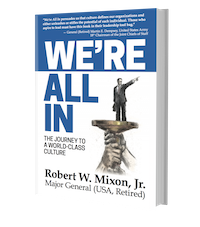
I didn’t always understand what a great culture looks like. In fact, as a young West Point cadet and later as an Army officer, I only had a vague notion of what a culture was at all.
We had a set way of doing things, to be sure, but it was pretty much taken for granted that we all knew why we did things “the military way.” Throughout my journey as a soldier, though, I came to understand that there was, indeed, a difference between healthy cultures and toxic ones. The former generated continued excellence because we were vested in the outcome; the latter drove off many of the best and brightest because there was no effort to make us want to buy in.
The sad part was that, in many cases, the toxic cultures endured for periods of time before their hollow infrastructures began to cave in. Many good officers and soldiers suffered when that time came.
The tipping point I experienced was in the mid-1970s in the U.S. Army in what was then West Germany. We literally encountered the perfect cultural storm—the clash of a draft Army with a new volunteer force, the widespread public disapproval of maintaining a large standing Army in the aftermath of the Vietnam defeat, the increasing popularity of drugs, and the continuing effects of racial bias.
As young officers, we often witnessed riots in the barracks and illegal behaviors by soldiers. Discipline was sporadic. Our vehicles lacked spare parts and fuel for training exercises that were badly needed to sustain combat readiness. We were becoming a hollow force.
The strong measures President Reagan put into place in the early 1980s enabled the U.S. military to slowly emerge from the cultural abyss that the organization was facing, but it took years to pull ourselves out of it. Those of us that survived said later that we could have predicted the outcome—but we were slow to anticipate the need for change until it was almost too late. We had to learn the hard way.
Developing A Level 5 Culture
The journey to developing a Level 5 culture is rooted in bringing the right values to life—values like integrity, trust, and transparency. It also includes modeling behaviors where leaders share credit for accomplishments while accepting responsibility for failures.
Level 5 leaders and teams model mutual accountability. The boss doesn’t have to chew anyone’s posterior, because peers chew each other’s posteriors when something doesn’t get done or doesn’t meet the standard.
What’s in it for us as corporate leaders to build and nurture a Level 5 culture? Clearly, it’s bottom line results and industry leadership. The most successful companies in the world today invest in having a world-class culture. These companies invest in their cultures, cultivate them, protect them. It is their corporate edge, delighting shareholders, to be sure, but also helping to establish themselves as leaders in their industry.
 This blog is based on chapter one from my book “We’re All In.” You can get a copy of all of the first chapter for free here.
This blog is based on chapter one from my book “We’re All In.” You can get a copy of all of the first chapter for free here.
If you’d like a full copy of the entire book, you can get it here.
Enjoy the journey!
(originally published March 2019)
Did you find this blog post beneficial? If so, please share it with your audience using one of the choices below. It’ll just take a second, but could improve someone’s work habits for a long time to come.





